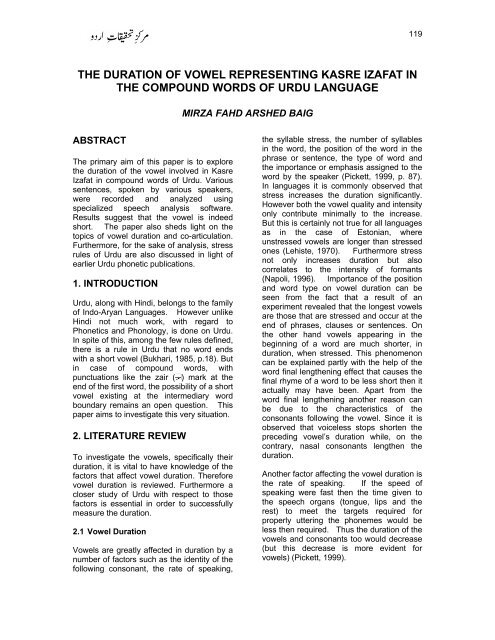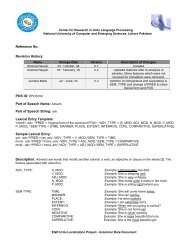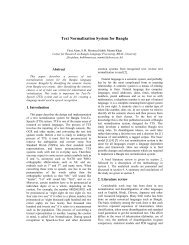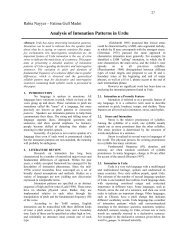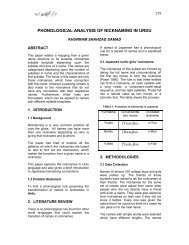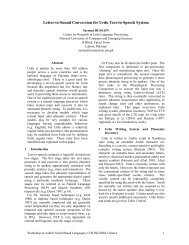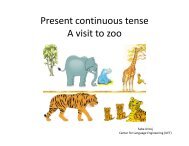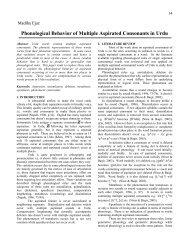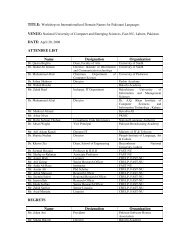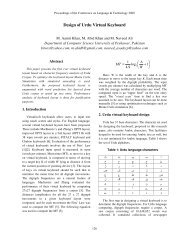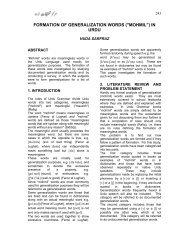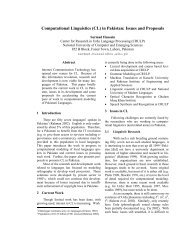the duration of vowel representing kasre izafat in the compound ...
the duration of vowel representing kasre izafat in the compound ...
the duration of vowel representing kasre izafat in the compound ...
You also want an ePaper? Increase the reach of your titles
YUMPU automatically turns print PDFs into web optimized ePapers that Google loves.
119THE DURATION OF VOWEL REPRESENTING KASRE IZAFAT INTHE COMPOUND WORDS OF URDU LANGUAGEMIRZA FAHD ARSHED BAIGABSTRACTThe primary aim <strong>of</strong> this paper is to explore<strong>the</strong> <strong>duration</strong> <strong>of</strong> <strong>the</strong> <strong>vowel</strong> <strong>in</strong>volved <strong>in</strong> KasreIzafat <strong>in</strong> <strong>compound</strong> words <strong>of</strong> Urdu. Varioussentences, spoken by various speakers,were recorded and analyzed us<strong>in</strong>gspecialized speech analysis s<strong>of</strong>tware.Results suggest that <strong>the</strong> <strong>vowel</strong> is <strong>in</strong>deedshort. The paper also sheds light on <strong>the</strong>topics <strong>of</strong> <strong>vowel</strong> <strong>duration</strong> and co-articulation.Fur<strong>the</strong>rmore, for <strong>the</strong> sake <strong>of</strong> analysis, stressrules <strong>of</strong> Urdu are also discussed <strong>in</strong> light <strong>of</strong>earlier Urdu phonetic publications.1. INTRODUCTIONUrdu, along with H<strong>in</strong>di, belongs to <strong>the</strong> family<strong>of</strong> Indo-Aryan Languages. However unlikeH<strong>in</strong>di not much work, with regard toPhonetics and Phonology, is done on Urdu.In spite <strong>of</strong> this, among <strong>the</strong> few rules def<strong>in</strong>ed,<strong>the</strong>re is a rule <strong>in</strong> Urdu that no word endswith a short <strong>vowel</strong> (Bukhari, 1985, p.18). But<strong>in</strong> case <strong>of</strong> <strong>compound</strong> words, withpunctuations like <strong>the</strong> zair ( ) mark at <strong>the</strong>end <strong>of</strong> <strong>the</strong> first word, <strong>the</strong> possibility <strong>of</strong> a short<strong>vowel</strong> exist<strong>in</strong>g at <strong>the</strong> <strong>in</strong>termediary wordboundary rema<strong>in</strong>s an open question. Thispaper aims to <strong>in</strong>vestigate this very situation.2. LITERATURE REVIEWTo <strong>in</strong>vestigate <strong>the</strong> <strong>vowel</strong>s, specifically <strong>the</strong>ir<strong>duration</strong>, it is vital to have knowledge <strong>of</strong> <strong>the</strong>factors that affect <strong>vowel</strong> <strong>duration</strong>. Therefore<strong>vowel</strong> <strong>duration</strong> is reviewed. Fur<strong>the</strong>rmore acloser study <strong>of</strong> Urdu with respect to thosefactors is essential <strong>in</strong> order to successfullymeasure <strong>the</strong> <strong>duration</strong>.2.1 Vowel DurationVowels are greatly affected <strong>in</strong> <strong>duration</strong> by anumber <strong>of</strong> factors such as <strong>the</strong> identity <strong>of</strong> <strong>the</strong>follow<strong>in</strong>g consonant, <strong>the</strong> rate <strong>of</strong> speak<strong>in</strong>g,<strong>the</strong> syllable stress, <strong>the</strong> number <strong>of</strong> syllables<strong>in</strong> <strong>the</strong> word, <strong>the</strong> position <strong>of</strong> <strong>the</strong> word <strong>in</strong> <strong>the</strong>phrase or sentence, <strong>the</strong> type <strong>of</strong> word and<strong>the</strong> importance or emphasis assigned to <strong>the</strong>word by <strong>the</strong> speaker (Pickett, 1999, p. 87).In languages it is commonly observed thatstress <strong>in</strong>creases <strong>the</strong> <strong>duration</strong> significantly.However both <strong>the</strong> <strong>vowel</strong> quality and <strong>in</strong>tensityonly contribute m<strong>in</strong>imally to <strong>the</strong> <strong>in</strong>crease.But this is certa<strong>in</strong>ly not true for all languagesas <strong>in</strong> <strong>the</strong> case <strong>of</strong> Estonian, whereunstressed <strong>vowel</strong>s are longer than stressedones (Lehiste, 1970). Fur<strong>the</strong>rmore stressnot only <strong>in</strong>creases <strong>duration</strong> but alsocorrelates to <strong>the</strong> <strong>in</strong>tensity <strong>of</strong> formants(Napoli, 1996). Importance <strong>of</strong> <strong>the</strong> positionand word type on <strong>vowel</strong> <strong>duration</strong> can beseen from <strong>the</strong> fact that a result <strong>of</strong> anexperiment revealed that <strong>the</strong> longest <strong>vowel</strong>sare those that are stressed and occur at <strong>the</strong>end <strong>of</strong> phrases, clauses or sentences. On<strong>the</strong> o<strong>the</strong>r hand <strong>vowel</strong>s appear<strong>in</strong>g <strong>in</strong> <strong>the</strong>beg<strong>in</strong>n<strong>in</strong>g <strong>of</strong> a word are much shorter, <strong>in</strong><strong>duration</strong>, when stressed. This phenomenoncan be expla<strong>in</strong>ed partly with <strong>the</strong> help <strong>of</strong> <strong>the</strong>word f<strong>in</strong>al leng<strong>the</strong>n<strong>in</strong>g effect that causes <strong>the</strong>f<strong>in</strong>al rhyme <strong>of</strong> a word to be less short <strong>the</strong>n itactually may have been. Apart from <strong>the</strong>word f<strong>in</strong>al leng<strong>the</strong>n<strong>in</strong>g ano<strong>the</strong>r reason canbe due to <strong>the</strong> characteristics <strong>of</strong> <strong>the</strong>consonants follow<strong>in</strong>g <strong>the</strong> <strong>vowel</strong>. S<strong>in</strong>ce it isobserved that voiceless stops shorten <strong>the</strong>preced<strong>in</strong>g <strong>vowel</strong>’s <strong>duration</strong> while, on <strong>the</strong>contrary, nasal consonants leng<strong>the</strong>n <strong>the</strong><strong>duration</strong>.Ano<strong>the</strong>r factor affect<strong>in</strong>g <strong>the</strong> <strong>vowel</strong> <strong>duration</strong> is<strong>the</strong> rate <strong>of</strong> speak<strong>in</strong>g. If <strong>the</strong> speed <strong>of</strong>speak<strong>in</strong>g were fast <strong>the</strong>n <strong>the</strong> time given to<strong>the</strong> speech organs (tongue, lips and <strong>the</strong>rest) to meet <strong>the</strong> targets required forproperly utter<strong>in</strong>g <strong>the</strong> phonemes would beless <strong>the</strong>n required. Thus <strong>the</strong> <strong>duration</strong> <strong>of</strong> <strong>the</strong><strong>vowel</strong>s and consonants too would decrease(but this decrease is more evident for<strong>vowel</strong>s) (Pickett, 1999).
120Center for Research <strong>in</strong> Urdu Language Process<strong>in</strong>g2.2 Co-ArticulationBesides <strong>the</strong> <strong>vowel</strong> <strong>duration</strong> factor ano<strong>the</strong>rphenomenon that can potentially affectacoustic analysis is co-articulation. Coarticulationis a term used to refer to <strong>the</strong><strong>in</strong>fluences <strong>of</strong> one sound on <strong>the</strong> articulation<strong>of</strong> o<strong>the</strong>r sounds <strong>in</strong> <strong>the</strong> same utterance. Thishappens ma<strong>in</strong>ly when <strong>the</strong> tongue articulationfails to atta<strong>in</strong> certa<strong>in</strong> targets. This failuremay be due to time shortage (if speak<strong>in</strong>gfast) or by target anticipation. It isanticipatory because <strong>the</strong> movements for asequence <strong>of</strong> sounds, syllables and wordsseem to prepare for later articulatorypatterns. This results <strong>in</strong> current parts <strong>of</strong> <strong>the</strong>utterance, be<strong>in</strong>g spoken, to be affected. Infact Pickett says co-articulation is <strong>the</strong> rule <strong>in</strong>speech production. Hence, it is common forconsecutive or adjacent phonemes to affecteach o<strong>the</strong>r (Pickett, 1999). Thus itbecomes imperative to keep co-articulation<strong>in</strong> m<strong>in</strong>d dur<strong>in</strong>g acoustic analysis <strong>of</strong> <strong>the</strong>speech signal.2.3 Stress <strong>in</strong> UrduS<strong>in</strong>ce, stress is a key factor affect<strong>in</strong>g <strong>vowel</strong><strong>duration</strong>. So, a review <strong>of</strong> <strong>the</strong> rules regard<strong>in</strong>gstress needs to be addressed. In Urdu,lexical stress doesn’t change <strong>the</strong> mean<strong>in</strong>g <strong>of</strong><strong>the</strong> word like it does <strong>in</strong> English. In Englishfor example, stress on <strong>the</strong> ‘<strong>in</strong>’ syllablemakes ‘<strong>in</strong>sult’ a noun while <strong>the</strong> stress on <strong>the</strong>‘sult’ syllable makes ‘<strong>in</strong>sult’ a verb.In Urdu <strong>the</strong> leng<strong>the</strong>n<strong>in</strong>g effect is not treatedas a supra-segmental feature but ra<strong>the</strong>r it,along with tone and stress, does affect<strong>in</strong>tonation patterns. Irrespective <strong>of</strong> that,leng<strong>the</strong>n<strong>in</strong>g does play a vital role <strong>in</strong> <strong>the</strong>rhythmic formation, as well as smooth flow<strong>of</strong> <strong>the</strong> sentence.In Urdu <strong>the</strong>re are three short <strong>vowel</strong>s [], []and [] for which punctuation marks paish( ), zair( ), zabar( ) are used respectively(Khan, 1997). One reason <strong>of</strong> why stress isnot dist<strong>in</strong>ctive <strong>in</strong> Urdu may be because <strong>the</strong>words are not dist<strong>in</strong>guished on <strong>the</strong> basis <strong>of</strong>stress alone. Ra<strong>the</strong>r <strong>the</strong> stress<strong>in</strong>g and destress<strong>in</strong>g<strong>of</strong> syllables is l<strong>in</strong>ked to syllableweight. As a rule though, tense or stressed<strong>vowel</strong>s are phonetically long (Kachru, 1987).Accord<strong>in</strong>g to ano<strong>the</strong>r study done by Hussa<strong>in</strong>(1997, p.121) lexical stress alters <strong>the</strong>phonetic properties <strong>of</strong> both <strong>vowel</strong>s andconsonants (Among o<strong>the</strong>rs, <strong>the</strong> <strong>duration</strong> <strong>of</strong>both, <strong>the</strong> <strong>vowel</strong>s and consonants, also<strong>in</strong>creases). Fur<strong>the</strong>rmore long <strong>vowel</strong>s <strong>in</strong> <strong>the</strong><strong>in</strong>itial syllable are, on average, twice as longas short <strong>vowel</strong>s <strong>in</strong> <strong>the</strong> <strong>in</strong>itial syllable.Besides <strong>the</strong> <strong>duration</strong>al <strong>in</strong>crease due tostress is different for <strong>vowel</strong>s <strong>in</strong> differentsyllables. Ano<strong>the</strong>r result <strong>of</strong> <strong>the</strong> study wasthat <strong>the</strong> <strong>vowel</strong> <strong>duration</strong> <strong>in</strong>creases least when<strong>the</strong> stressed <strong>vowel</strong> is <strong>in</strong> <strong>the</strong> <strong>in</strong>itial syllableand most when it is <strong>in</strong> <strong>the</strong> last syllable (asreviewed earlier word f<strong>in</strong>al leng<strong>the</strong>n<strong>in</strong>g mayhave a role to play here) (Hussa<strong>in</strong>, 1997, p.121).2.4 SummaryDuration <strong>of</strong> a <strong>vowel</strong> depends on manyfactors <strong>of</strong> which stress is very common andimportant. With respect to Urdu, stressdoes exist but may be unimportantphonetically as po<strong>in</strong>ted out by some authors.Though stress does affect <strong>vowel</strong>sphonetically, by elongat<strong>in</strong>g that <strong>vowel</strong>.Co-articulation is also an important issuewhen acoustic analysis is be<strong>in</strong>g donebecause it is happen<strong>in</strong>g all <strong>the</strong> time. Theoccurrence <strong>of</strong> co-articulation can make itdifficult to identify <strong>the</strong> exact boundaries <strong>of</strong><strong>vowel</strong>s accurately.3. MethodologyAs seen from <strong>the</strong> reviewed literature, <strong>in</strong> <strong>the</strong>previous section, <strong>the</strong> zair ( ) punctuationmark would produce a short <strong>vowel</strong> (//)sound. On <strong>the</strong> o<strong>the</strong>r hand it is alsoreviewed that stress could elongate <strong>the</strong>short <strong>vowel</strong> to some extent. Keep<strong>in</strong>g <strong>the</strong>seth<strong>in</strong>gs <strong>in</strong> m<strong>in</strong>d, an experiment is to bedevised such that <strong>the</strong> <strong>vowel</strong> (//) is verifiedas a short <strong>vowel</strong>.3.1 StimuliFor <strong>the</strong> proper verification <strong>of</strong> <strong>the</strong> short <strong>vowel</strong>,<strong>compound</strong> words were taken which had <strong>the</strong>zair ( ) punctuation mark at <strong>the</strong> end <strong>of</strong> <strong>the</strong>first word. Words were taken from <strong>the</strong> Urdulexicon and where possible highly familiarwords were selected. The experiment was
121designed with limited knowledge <strong>of</strong> <strong>the</strong>phonology and phonetics <strong>of</strong> Urdu.Fur<strong>the</strong>rmore ten most familiar words wereselected without any apparent considerationon <strong>the</strong>ir particular word structure. Table 1 is<strong>the</strong> list <strong>of</strong> words used for <strong>the</strong> experiment.TABLE 1 Words, along with <strong>the</strong>ir phonetictranscription, used <strong>in</strong> <strong>the</strong> experiment.WordsQuaid-e-Azam(Founder <strong>of</strong>Pakistan)Rad-e-Amal(Reaction)M<strong>in</strong>ar-e-Pakistan(A monument)Bagh-e-J<strong>in</strong>nnah(Name <strong>of</strong> agarden)Aqwam-e-Mutahida(United Nations)Janab-e-Aali(Your Honour)Sitara-e-Imtiaz(Honorary medal)Azab-e-Qabr(Torment <strong>of</strong>grave)Dawat-e-Aam(Open <strong>in</strong>vitation)Sahib-e-Hasiat(Capable person)Transcriptionqaid azmrd amalmnar pakstanba dnaaqvam mthdadnab alistara mtazazab qbrdawt amsahb hestThe bold symbol is <strong>the</strong> targeted short <strong>vowel</strong>.Each word was embedded <strong>in</strong> a carriersentence. Table 2 is <strong>the</strong> list <strong>of</strong> words thatconta<strong>in</strong>ed <strong>the</strong> selected long <strong>vowel</strong> (Theselected long <strong>vowel</strong> is bold and separatedwith space <strong>in</strong> order to clarify it).The transcription <strong>of</strong> <strong>the</strong> entire sentences isgiven <strong>in</strong> <strong>the</strong> Appendix A.microphone (low rated impedance (Z) <strong>of</strong>150-180Ω) with a frequency response <strong>of</strong> 80to 14000Hz. The microphone used, alsohad a built-<strong>in</strong> lock<strong>in</strong>g on/<strong>of</strong>f switch on it.Fur<strong>the</strong>rmore a high quality <strong>in</strong>tegrated stereoamplifier supported <strong>the</strong> microphone. Allcoupled with a very high standard Sound-Blaster Card ensured m<strong>in</strong>imum loss <strong>of</strong> datato noise and o<strong>the</strong>r <strong>in</strong>terferences. Along withthat Praat 4. 0 sound record<strong>in</strong>g system, TheSoundRecorder, was used (configured toproduce 16KHz WAV files).The Speech Analysis apparatus <strong>in</strong>cluded <strong>the</strong>Praat 4.0 speech analyzer and <strong>the</strong> SpeechAnalyzer 1.5. Fur<strong>the</strong>rmore a pair <strong>of</strong> highperform<strong>in</strong>g speakers was used. Beside thatMicros<strong>of</strong>t Excel is used for stor<strong>in</strong>g <strong>the</strong> time<strong>duration</strong>s as well as do<strong>in</strong>g <strong>the</strong> statisticalanalysis.TABLE 2 Words conta<strong>in</strong><strong>in</strong>g <strong>the</strong> selected long<strong>vowel</strong>s.WordsAzadi(Independence)Shadeed(Extreme)Sair(Recreational tour)Bagh(Garden)Pantalis(fourty-five)Janab(Sir)Sitara(Star)Hamaen(We)Iftar(Break<strong>in</strong>g <strong>of</strong> fast)Ko(About)Transcriptionaz a did i ds æ rb a pent a lisdn a bst a rahm eft a rk o3.2 ApparatusThe apparatus used for <strong>the</strong> experiment canbe categorized <strong>in</strong>to two broad categories:Record<strong>in</strong>g apparatus and Speech Analysisapparatus. The record<strong>in</strong>g apparatus<strong>in</strong>cluded first and foremost a dynamic3.3 SpeakersSpeakers are an important part <strong>of</strong> <strong>the</strong>experiment. Six male speakers are used <strong>in</strong><strong>the</strong> experiment, referred to as RS, AG, BA,AK, SS and GS. All <strong>of</strong> <strong>the</strong> six speakers’native language is Urdu. Besides, all <strong>of</strong>
122Center for Research <strong>in</strong> Urdu Language Process<strong>in</strong>g<strong>the</strong>m are currently students pursu<strong>in</strong>g abachelor’s degree <strong>in</strong> Computer Science fromNational University <strong>of</strong> Computer andEmerg<strong>in</strong>g Sciences (NUCES). All <strong>of</strong> <strong>the</strong>speakers can understand Punjabi. AG andGS also speak Punjabi actively dur<strong>in</strong>g <strong>the</strong>irdaily-life rout<strong>in</strong>e. All <strong>the</strong> speakers werejudged to have normal speech and hear<strong>in</strong>g.All <strong>the</strong> speakers were naïve about <strong>the</strong>purpose <strong>of</strong> <strong>the</strong> experiment. Two speakers,GS and SS, had no prior experience <strong>of</strong>do<strong>in</strong>g any phonetic or speech experiment <strong>of</strong>any sort. On <strong>the</strong> contrary <strong>the</strong> rema<strong>in</strong><strong>in</strong>gfour have been participat<strong>in</strong>g <strong>in</strong> some sort <strong>of</strong>phonetic or speech related experiments <strong>in</strong><strong>the</strong> current past.normalized <strong>vowel</strong> <strong>duration</strong>s were alsocalculated and stored <strong>in</strong> thosespreadsheets.3.5 AnalysisFor analysis Praat 4.0 speech analysis tool,along with <strong>the</strong> Speech Analyzer was used.Both tools provide <strong>the</strong> facilities for <strong>in</strong>spect<strong>in</strong>g<strong>the</strong> spectrogram along with <strong>the</strong> properzoom<strong>in</strong>g and time <strong>duration</strong> calculationfacilities.3.4 ProceduresFirst, ten <strong>compound</strong> words <strong>of</strong> Urdu, with <strong>the</strong>zair ( ) punctuation placed at <strong>the</strong> end <strong>of</strong> <strong>the</strong>first word, are sought. These ten words aremade <strong>in</strong>to ten sentences. In order to avoidemphatic stress and <strong>in</strong>tonation, possiblyaffect<strong>in</strong>g <strong>the</strong> <strong>vowel</strong> <strong>duration</strong>s, <strong>the</strong>sesentences are created as simplestatements. All <strong>of</strong> <strong>the</strong>se ten sentences are<strong>the</strong>n written legibly on ten cards (Each cardconta<strong>in</strong><strong>in</strong>g one sentence). All <strong>of</strong> <strong>the</strong> tencards are properly shuffled and presented to<strong>the</strong> speaker.The speakers were advised to read <strong>the</strong>sentences out as if speak<strong>in</strong>g <strong>the</strong>m <strong>in</strong> <strong>the</strong>irdaily rout<strong>in</strong>e, keep<strong>in</strong>g <strong>the</strong> sentences assimple statements and not <strong>in</strong>troduc<strong>in</strong>g anysort <strong>of</strong> undue <strong>in</strong>tonation or emphatic stress.Fur<strong>the</strong>rmore <strong>the</strong>y were cautioned not torecite <strong>the</strong> sentences too slowly or too quick,but ra<strong>the</strong>r at <strong>the</strong>ir natural speak<strong>in</strong>g pace.Each sentence was recorded one at a time.Once <strong>the</strong> ten sentences were recorded, <strong>the</strong>speakers were given a short break while <strong>the</strong>cards were reshuffled. They <strong>the</strong>n read <strong>the</strong>cards aga<strong>in</strong>. The whole procedure wasrepeated five times <strong>in</strong> a block-randomizeddesign. By do<strong>in</strong>g this each speaker endedup record<strong>in</strong>g five files per sentence. Thus<strong>the</strong>re were fifty files per speaker. And s<strong>in</strong>ce<strong>the</strong>re are six speakers so all <strong>in</strong> all <strong>the</strong>re werethree hundred recorded files <strong>in</strong> total to beanalyzed. For each sentence, <strong>the</strong> <strong>duration</strong><strong>of</strong> each speaker’s long and short <strong>vowel</strong>s,measured <strong>in</strong> seconds, was recorded <strong>in</strong>Micros<strong>of</strong>t Excel spread-sheets. TheFIGURE 1 Spectrogram, mark<strong>in</strong>g <strong>duration</strong> <strong>of</strong> //For analysis, time <strong>duration</strong> (<strong>in</strong> seconds) <strong>of</strong><strong>the</strong> targeted <strong>vowel</strong> is measured alongsidewith <strong>the</strong> <strong>duration</strong> <strong>of</strong> any one <strong>of</strong> <strong>the</strong> long<strong>vowel</strong>s spoken <strong>in</strong> <strong>the</strong> sentence (For <strong>the</strong>purpose <strong>of</strong> proper comparison, <strong>the</strong> chosenlong <strong>vowel</strong> <strong>in</strong> a sentence rema<strong>in</strong>s <strong>the</strong> samefor each <strong>of</strong> <strong>the</strong> speaker). Due to <strong>the</strong> vary<strong>in</strong>gspeaker speak<strong>in</strong>g pace, care needs to betaken <strong>in</strong> select<strong>in</strong>g <strong>the</strong> long <strong>vowel</strong>. Forproper and effective <strong>in</strong>terpretation <strong>the</strong>targeted <strong>vowel</strong> <strong>duration</strong> is normalized that isits ratio with <strong>the</strong> long <strong>vowel</strong> is taken. Thiswould thus give us <strong>the</strong> relative length <strong>of</strong> <strong>the</strong>targeted <strong>vowel</strong> with respect to <strong>the</strong> long<strong>vowel</strong> selected lead<strong>in</strong>g to a conclusive<strong>in</strong>ference <strong>of</strong> <strong>the</strong> result.For each <strong>vowel</strong> <strong>the</strong> time <strong>duration</strong> (<strong>in</strong>seconds) is calculated by subtract<strong>in</strong>g <strong>the</strong>time <strong>of</strong> <strong>the</strong> marker at <strong>the</strong> <strong>of</strong>fset <strong>of</strong> <strong>the</strong> <strong>vowel</strong>with <strong>the</strong> one on its onset. As <strong>in</strong> Figure1 <strong>the</strong><strong>duration</strong> for <strong>the</strong> short <strong>vowel</strong> is measured bysubtract<strong>in</strong>g <strong>the</strong> values <strong>in</strong>dicated on <strong>the</strong> top
123<strong>of</strong> <strong>the</strong> w<strong>in</strong>dow. The s<strong>of</strong>tware shows bothtimes <strong>in</strong> seconds. It is to be noted that <strong>the</strong><strong>duration</strong> marked <strong>in</strong> <strong>the</strong> figure is actuallydemarcated by properly zoom<strong>in</strong>g <strong>in</strong> to get<strong>the</strong> proper limits <strong>of</strong> <strong>the</strong> <strong>vowel</strong> boundary.Fur<strong>the</strong>rmore co-articulation also comes <strong>in</strong>toplay, as a speaker’s natural speak<strong>in</strong>g pacemay be fast enough to cause it. Asreviewed, <strong>the</strong> <strong>duration</strong> <strong>of</strong> <strong>the</strong> <strong>vowel</strong> <strong>in</strong> coarticulationis calculated betweenboundaries <strong>in</strong> which that <strong>vowel</strong> can bedist<strong>in</strong>ctly heard and that <strong>the</strong> formants rema<strong>in</strong>fairly constant. Figure 2 shows that case.Consequently, ten lowest values areextracted, one from each <strong>of</strong> <strong>the</strong> tensentences. Thus each speaker’s m<strong>in</strong>imumNormalised Vowel Duration0.70.60.50.40.30.20.10RS AG BA AK SS GS AVGSpeakersM<strong>in</strong>imumMaximumAverageFIGURE 3 Maximum, m<strong>in</strong>imum and averagevalues <strong>of</strong> Normalized Vowel Duration <strong>of</strong> eachspeaker.FIGURE 2 spectrogram, mark<strong>in</strong>g <strong>the</strong> <strong>duration</strong> <strong>of</strong> //when co-articulated with <strong>the</strong> <strong>vowel</strong> follow<strong>in</strong>g it.4. ResultsFigure 3 shows <strong>the</strong> variation <strong>of</strong> <strong>vowel</strong><strong>duration</strong> made by each <strong>of</strong> <strong>the</strong> six speakers.Firstly <strong>the</strong> Normalized Vowel Duration iscalculated by divid<strong>in</strong>g <strong>the</strong> <strong>duration</strong> <strong>of</strong> <strong>the</strong>short <strong>vowel</strong>, <strong>in</strong> seconds, with that <strong>of</strong> <strong>the</strong> long<strong>vowel</strong>, also <strong>in</strong> seconds. The figure alsoshows <strong>the</strong> m<strong>in</strong>imum, average and <strong>the</strong>maximum values <strong>of</strong> <strong>the</strong> normalized <strong>vowel</strong>.Each speaker’s m<strong>in</strong>imum value is calculatedby first select<strong>in</strong>g <strong>the</strong> smallest value <strong>of</strong> <strong>the</strong>five record<strong>in</strong>gs <strong>of</strong> every sentence.value is taken as <strong>the</strong> average <strong>of</strong> <strong>the</strong>se tenvalues. Similarly <strong>the</strong> highest value among<strong>the</strong> five record<strong>in</strong>gs <strong>of</strong> every sentence isextracted. This leads to ten highest valuesone from each sentence. The average <strong>of</strong><strong>the</strong>se ten values yields <strong>the</strong> averagemaximum value that <strong>the</strong> speaker achieved.Calculat<strong>in</strong>g <strong>the</strong> average value is just <strong>the</strong>same. Instead <strong>of</strong> select<strong>in</strong>g <strong>the</strong> m<strong>in</strong>imum ormaximum value, <strong>the</strong> average <strong>of</strong> <strong>the</strong> fiverecord<strong>in</strong>gs is calculated. S<strong>in</strong>ce <strong>the</strong>re areten sentences, ten average values areextracted. The average <strong>of</strong> <strong>the</strong>se tennumbers would give <strong>the</strong> average value perspeaker per sentence. Average bars arealso plotted alongside <strong>the</strong> six speaker bars.The m<strong>in</strong>imum value is <strong>the</strong> average <strong>of</strong> <strong>the</strong> sixlowest values as plotted <strong>in</strong> <strong>the</strong> figure. It is<strong>the</strong> case for <strong>the</strong> average’s maximum andaverage values.Figure 4 shows a l<strong>in</strong>e graph depict<strong>in</strong>g <strong>the</strong>maximum, m<strong>in</strong>imum and average <strong>vowel</strong><strong>duration</strong>s per sentence. For calculat<strong>in</strong>g <strong>the</strong>maximum value, an average <strong>of</strong> <strong>the</strong> fiverecord<strong>in</strong>gs is done for each <strong>of</strong> <strong>the</strong> sixspeakers. Then <strong>of</strong> those six averages <strong>the</strong>maximum is chosen. Calculat<strong>in</strong>g <strong>the</strong>m<strong>in</strong>imum value is similar to that <strong>of</strong> <strong>the</strong>maximum value. Similarly for <strong>the</strong> average
124Center for Research <strong>in</strong> Urdu Language Process<strong>in</strong>gvalue, <strong>the</strong> average <strong>of</strong> five record<strong>in</strong>gs isdone. F<strong>in</strong>ally <strong>the</strong> Average <strong>of</strong> <strong>the</strong> six averagevalues would yield an average value <strong>of</strong> all<strong>the</strong> speakers per sentence.Fur<strong>the</strong>rmore <strong>the</strong> figure shows a thickhorizontal l<strong>in</strong>e just above <strong>the</strong> 0.5 mark.This is actually <strong>the</strong> average <strong>of</strong> <strong>the</strong> tenaverage values.Normalised VowelDuration0.90.80.70.60.50.40.35. Discussions1 2 3 4 5 6 7 8 9 10SentencesMaximumM<strong>in</strong>imumAverageAverage <strong>vowel</strong> lengthFIGURE 4: maximum, m<strong>in</strong>imum and averagenormalized <strong>vowel</strong> <strong>duration</strong> <strong>of</strong> each sentence.The results suggest that <strong>the</strong> <strong>duration</strong> <strong>of</strong> <strong>the</strong>short <strong>vowel</strong> // is on average less <strong>the</strong>n that<strong>of</strong> <strong>the</strong> long <strong>vowel</strong>. The long <strong>vowel</strong> is onaverage double <strong>in</strong> <strong>duration</strong> as compared to<strong>the</strong> short <strong>vowel</strong> (approx 0.52 <strong>in</strong> ratio to along <strong>vowel</strong>).The range <strong>of</strong> <strong>duration</strong> <strong>of</strong> <strong>the</strong> short <strong>vowel</strong>,however, varied from speaker to speakerand also from sentence to sentence. Therange, though, was from approximately 0.3to 0.8, but that was by some speakers <strong>in</strong> ahandful <strong>of</strong> cases.By look<strong>in</strong>g at <strong>the</strong> figures <strong>in</strong> <strong>the</strong> Appendix B(p.13-14) it can be seen that most <strong>of</strong>speakers altered <strong>the</strong> lengths <strong>of</strong> <strong>vowel</strong> evenfor <strong>the</strong> same sentence suggest<strong>in</strong>g that <strong>the</strong>ywere perhaps stress<strong>in</strong>g <strong>the</strong> short <strong>vowel</strong> justa bit at times. Apart from this, <strong>the</strong> short<strong>vowel</strong> comes right at <strong>the</strong> end <strong>of</strong> <strong>the</strong> firstword <strong>of</strong> <strong>the</strong> <strong>compound</strong> word suggest<strong>in</strong>g thatword f<strong>in</strong>al leng<strong>the</strong>n<strong>in</strong>g may be play<strong>in</strong>g itsrole, <strong>in</strong> elongat<strong>in</strong>g <strong>the</strong> last rhyme <strong>of</strong> <strong>the</strong>word, which <strong>in</strong> this case would be <strong>the</strong> short<strong>vowel</strong>. However if <strong>the</strong> results <strong>of</strong> all <strong>the</strong>sentences are viewed, it can be seen that<strong>the</strong> <strong>duration</strong> on some <strong>in</strong>stances (likesentence 4 and 6, Appendix B p. 13-14)rema<strong>in</strong> small. This usually happened if <strong>the</strong>second word <strong>of</strong> <strong>the</strong> <strong>compound</strong> word startswith a consonant (sentence 5, Appendix B p.13-14, be<strong>in</strong>g a big exception). On <strong>the</strong>contrary <strong>the</strong> <strong>duration</strong> <strong>of</strong> <strong>vowel</strong> altered greatlywhen <strong>the</strong> second word started with a <strong>vowel</strong>.Some speakers kept it smaller on someoccasions and elongated it a bit on o<strong>the</strong>roccasions. Ano<strong>the</strong>r trend observed wasthat some speakers (usually AG and BA),keep<strong>in</strong>g up with <strong>the</strong>ir natural pace, usuallypreferred to stop <strong>in</strong> between <strong>the</strong> two wordsthus elongat<strong>in</strong>g <strong>the</strong> short <strong>vowel</strong> just a bitwhile o<strong>the</strong>rs didn’t. The o<strong>the</strong>rs, wherepossible, carried on utter<strong>in</strong>g <strong>the</strong> secondword result<strong>in</strong>g <strong>in</strong> co-articulation. The<strong>vowel</strong>s have to be different though as thiswasn’t observed <strong>in</strong> sentence 7 (Appendix Bp. 13-14) where most speakers preferred tobreak <strong>the</strong> <strong>compound</strong> after <strong>the</strong> first word.All <strong>in</strong> all, irrespective <strong>of</strong> variations, <strong>the</strong><strong>duration</strong> <strong>of</strong> <strong>the</strong> <strong>vowel</strong> rema<strong>in</strong>ed about half<strong>the</strong> size <strong>of</strong> a long <strong>vowel</strong> suggest<strong>in</strong>g that itrema<strong>in</strong>ed a short <strong>vowel</strong> (approximately 0.52<strong>in</strong> ratio to a long <strong>vowel</strong>). This fur<strong>the</strong>r leadsto <strong>the</strong> conclusion that <strong>kasre</strong> Izafatrepresents a short <strong>vowel</strong> and <strong>in</strong> consonant<strong>vowel</strong>(CV) configuration (with ‘V’ be<strong>in</strong>g <strong>the</strong>short <strong>vowel</strong>) can occur exceptionally at wordend<strong>in</strong>g <strong>in</strong> <strong>compound</strong> words.6. ReferencesBukhari, S. 1985. Phonology <strong>of</strong> UrduLanguage. Karachi, Pakistan.Hussa<strong>in</strong>, S. 1997. Phonetic Correlates <strong>of</strong>lexical Stress <strong>in</strong> Urdu, Unpublished Ph.D.dissertation, Northwestern University, IL,USA.
125Kachru, Y. 1987. “H<strong>in</strong>di-Urdu”, <strong>in</strong> The MajorLanguages <strong>of</strong> South Asia, The Middle Eastand Africa. Comrie, B (eds.). Routledge,London, UK.Khan, M. 1997. Urdu ka Sauti Kaida,Islamabad, Pakistan.Lehiste, I. 1970, Suprasegmentals.Cambridge: Massachusetts Institute <strong>of</strong>Technology Press, USA.Napoli, D. 1996. L<strong>in</strong>guistics an <strong>in</strong>troduction.New York, USA.Pickett, J. 1999. The Acoustics <strong>of</strong> SpeechCommunication. Fundamentals, SpeechPerception Theory, And Technology.Massachusetts USA.
126Center for Research <strong>in</strong> Urdu Language Process<strong>in</strong>g7. APPENDICIESAppendix A Transcription <strong>of</strong> sentences used for <strong>the</strong> experimentFollow<strong>in</strong>g are <strong>the</strong> transcriptions <strong>of</strong> <strong>the</strong> sentences used <strong>in</strong> <strong>the</strong> experiment. The short <strong>vowel</strong> (//)and <strong>the</strong> long <strong>vowel</strong> used for normalization <strong>of</strong> <strong>vowel</strong> <strong>duration</strong> are shown <strong>in</strong> bold face.1. hme qid zm n zdi dli.(We got <strong>in</strong>dependence because <strong>of</strong> Quaid -e- Azam).2. us k red ml bhot did t.(His reaction was very extreme).3. hm sær kr næ mnr pkstn e.(We made a recreational trip to M<strong>in</strong>ar-e-Pakistan).4. lhor ke mhur bo me ek b b dn hæ.Bagh-e-J<strong>in</strong>nah is one <strong>of</strong> <strong>the</strong> famous gardens <strong>of</strong> Lahore).5. qvm mthd unis s pæntlis me kim hui.(United Nations was formed <strong>in</strong> 1945).6. dnb li un ko bizt bri kij de.(I request Your Honor to set him free).7. mude str mtz dij de.(Award me Sitara-e-Imtiaz).8. hme zb qbr se btn tahije.(We should save ourselves from <strong>the</strong> torments <strong>of</strong> <strong>the</strong> grave).9. un ki ftr prti me sb ko dvt m he.(There is an open <strong>in</strong>vitation for <strong>the</strong>ir Iftar party).10. shb hest loo ko rib loo ki mdd krni thije.(Rich people should help <strong>the</strong> poor).
127Appendix B Results <strong>of</strong> <strong>the</strong> ExperimentBelow is <strong>the</strong> experiment result data. All values are <strong>duration</strong>s <strong>in</strong> seconds except for <strong>the</strong>normalization column, which is <strong>the</strong> ratio <strong>of</strong> short <strong>vowel</strong> to <strong>the</strong> long <strong>vowel</strong>.TABLE B.1 Sentence 1Speaker target <strong>vowel</strong> long <strong>vowel</strong> (azadi) normalisedRS 0.052 0.092 0.565AG 0.057 0.098 0.577BA 0.061 0.111 0.553AK 0.060 0.089 0.680SS 0.051 0.098 0.524GS 0.055 0.105 0.529Sentence Average 0.056 0.099 0.571TABLE B.2 Sentence 2Speaker target <strong>vowel</strong> long <strong>vowel</strong> (shadid) normalisedRS 0.056 0.094 0.594AG 0.072 0.115 0.627BA 0.059 0.114 0.523AK 0.053 0.103 0.513SS 0.046 0.092 0.506GS 0.065 0.125 0.519Sentence Average 0.058 0.107 0.547
128Center for Research <strong>in</strong> Urdu Language Process<strong>in</strong>gTABLE B.3 Sentence 3Speaker target <strong>vowel</strong> long <strong>vowel</strong> (ser) normalisedRS 0.060 0.113 0.529AG 0.063 0.135 0.464BA 0.062 0.168 0.374AK 0.058 0.141 0.411SS 0.051 0.135 0.380GS 0.069 0.163 0.427Sentence Average 0.060 0.143 0.431TABLE B.4 Sentence 4Speaker target <strong>vowel</strong> long <strong>vowel</strong> (bagh) normalisedRS 0.069 0.166 0.418AG 0.079 0.161 0.493BA 0.075 0.186 0.397AK 0.081 0.176 0.463SS 0.081 0.183 0.449GS 0.090 0.200 0.453Sentence Average 0.079 0.179 0.445TABLE B.5 Sentence 5Speaker target <strong>vowel</strong> long <strong>vowel</strong> (-talis) normalisedRS 0.050 0.080 0.618AG 0.077 0.094 0.818BA 0.069 0.102 0.675AK 0.062 0.086 0.723SS 0.057 0.087 0.654GS 0.057 0.115 0.500Sentence Average 0.062 0.094 0.665
129TABLE B.6 Sentence 6Speaker target <strong>vowel</strong> long <strong>vowel</strong> (janab) normalisedRS 0.063 0.115 0.549AG 0.079 0.095 0.837BA 0.066 0.117 0.570AK 0.073 0.097 0.755SS 0.064 0.110 0.586GS 0.084 0.117 0.716Sentence Average 0.072 0.109 0.669TABLE B.7 Sentence 7Speaker target <strong>vowel</strong> long <strong>vowel</strong> (sitara-) normalisedRS 0.045 0.111 0.401AG 0.054 0.125 0.432BA 0.051 0.120 0.421AK 0.046 0.128 0.358SS 0.045 0.109 0.409GS 0.052 0.132 0.390Sentence Average 0.049 0.121 0.402TABLE B.8 Sentence 8Speaker target <strong>vowel</strong> long <strong>vowel</strong> (hamaen) normalisedRS 0.058 0.118 0.495AG 0.073 0.126 0.577BA 0.069 0.110 0.634AK 0.062 0.117 0.533SS 0.052 0.114 0.460GS 0.074 0.122 0.606Sentence Average 0.065 0.118 0.551
130Center for Research <strong>in</strong> Urdu Language Process<strong>in</strong>gTABLE B.9 Sentence 9Speaker target <strong>vowel</strong> long <strong>vowel</strong> (iftar) normalisedRS 0.052 0.121 0.430AG 0.076 0.134 0.570BA 0.081 0.161 0.504AK 0.062 0.133 0.468SS 0.057 0.132 0.439GS 0.082 0.171 0.476Sentence Average 0.068 0.142 0.481TABLE B.10 Sentence 10Speaker target <strong>vowel</strong> long <strong>vowel</strong> (ko) normalisedRS 0.058 0.126 0.464AG 0.071 0.124 0.574BA 0.088 0.153 0.582AK 0.077 0.133 0.581SS 0.059 0.131 0.456GS 0.074 0.175 0.421Sentence Average 0.071 0.140 0.513
131Follow<strong>in</strong>g are <strong>the</strong> distribution <strong>of</strong> normalized short <strong>vowel</strong> <strong>duration</strong> <strong>of</strong> each speaker withrespect to sentences:Speaker: RSNormalised <strong>vowel</strong><strong>duration</strong>0.80.60.40.201 2 3 4 5 6 7 8 9 10SentencesIst Try2nd Try3rd Try4th Try5th TryFIGURE B.1: Variation <strong>of</strong> <strong>vowel</strong> <strong>duration</strong> <strong>of</strong> speaker RS across <strong>the</strong> ten sentences.Speaker: AG1Normalized <strong>vowel</strong><strong>duration</strong>0.80.60.40.21st Try2nd Try3rd Try4th Try5th Try01 2 3 4 5 6 7 8 9 10SentencesFIGURE B.2: Variation <strong>of</strong> <strong>vowel</strong> <strong>duration</strong> <strong>of</strong> speaker AG across <strong>the</strong> ten sentences.Normalised VowelDuration0.90.80.70.60.50.40.30.20.10Speaker: BA1 2 3 4 5 6 7 8 9 10Sentences1st Try2nd Try3rd Try4th Try5th TryFIGURE B.3: Variation <strong>of</strong> <strong>vowel</strong> <strong>duration</strong> <strong>of</strong> speaker BA across <strong>the</strong> ten sentences.
132Center for Research <strong>in</strong> Urdu Language Process<strong>in</strong>gNormalized VowelDuration0.90.80.70.60.50.40.30.20.10Speaker: AK1 2 3 4 5 6 7 8 9 10Sentences1st Try2nd Try3rd Try4th Try5th TryFIGURE B.4: Variation <strong>of</strong> <strong>vowel</strong> <strong>duration</strong> <strong>of</strong> speaker AK across <strong>the</strong> ten sentences.Normalized VowelDuration0.80.70.60.50.40.30.20.10Speaker: SS1st Try2nd Try3rd Try4th Try5th Try1 2 3 4 5 6 7 8 9 10SentencesFIGURE B.5: Variation <strong>of</strong> <strong>vowel</strong> <strong>duration</strong> <strong>of</strong> speaker SS across <strong>the</strong> ten sentences.Normalised VowelDuration0.90.80.70.60.50.40.30.20.10Speaker: GS1 2 3 4 5 6 7 8 9 10Sentences1st Try2nd Try3rd Try4th Try5th TryFIGURE B.6: Variation <strong>of</strong> <strong>vowel</strong> <strong>duration</strong> <strong>of</strong> speaker GS across <strong>the</strong> ten sentences.


